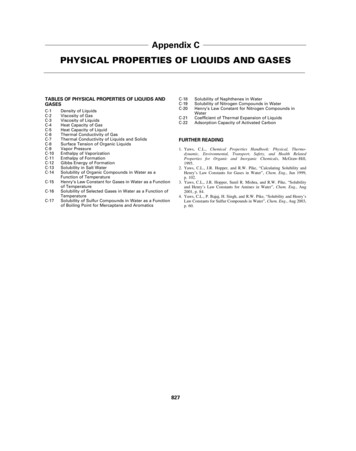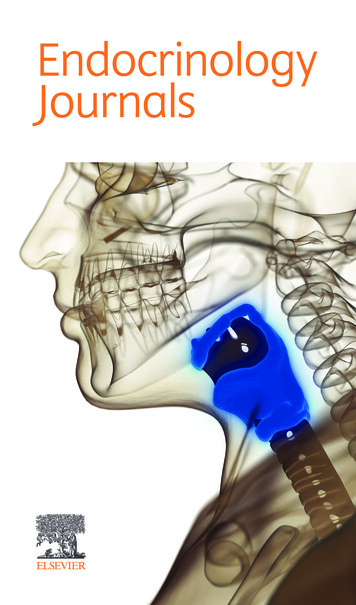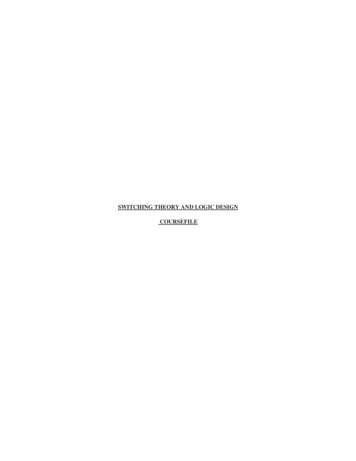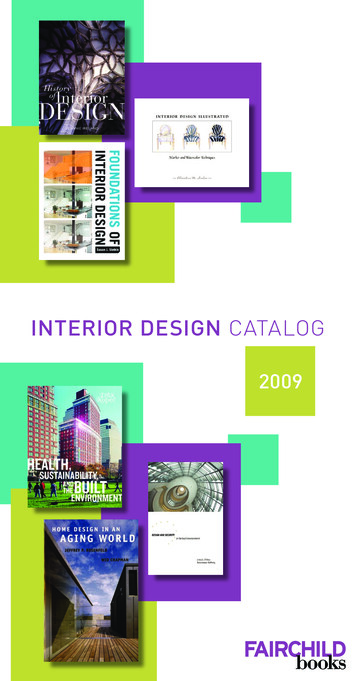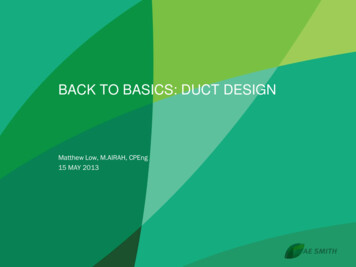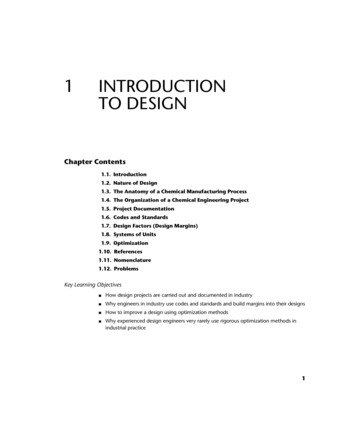
Transcription
Towler & Sinnot / Towler & Sinnott1Chap01 Final Proof page 1 27.10.2007 4:29pm Compositor Name: jananthakumarINTRODUCTIONTO DESIGNChapter Contents1.1. Introduction1.2. Nature of Design1.3. The Anatomy of a Chemical Manufacturing Process1.4. The Organization of a Chemical Engineering Project1.5. Project Documentation1.6. Codes and Standards1.7. Design Factors (Design Margins)1.8. Systems of Units1.9. Optimization1.10. References1.11. Nomenclature1.12. ProblemsKey Learning Objectives&How design projects are carried out and documented in industry&Why engineers in industry use codes and standards and build margins into their designs&How to improve a design using optimization methods&Why experienced design engineers very rarely use rigorous optimization methods inindustrial practice1
Towler & Sinnot / Towler & Sinnott21.1.Chap01 Final Proof page 2 27.10.2007 4:29pm Compositor Name: jananthakumarCHAPTER 1INTRODUCTION TO DESIGNINTRODUCTIONThis chapter is an introduction to the nature and methodology of the design processand its application to the design of chemical manufacturing processes.1.2.NATURE OF DESIGNThis section is a general discussion of the design process. The subject of this book ischemical engineering design, but the methodology described in this section appliesequally to other branches of engineering.Chemical engineering has consistently been one of the highest paid engineeringprofessions. There is a demand for chemical engineers in many sectors of industry,including the traditional processing industries: chemicals, polymers, fuels, foods, pharmaceuticals, and paper, as well as other sectors such as electronic materials and devices,consumer products, mining and metals extraction, biomedical implants, and powergeneration.The reason that companies in such a diverse range of industries value chemicalengineers so highly is the following:Starting from a vaguely defined problem statement such as a customer need or a set ofexperimental results, chemical engineers can develop an understanding of the importantunderlying physical science relevant to the problem and use this understanding to create aplan of action and set of detailed specifications which, if implemented, will lead to apredicted financial outcome.The creation of plans and specifications and the prediction of the financial outcomeif the plans were implemented is the activity of chemical engineering design.Design is a creative activity, and as such can be one of the most rewarding andsatisfying activities undertaken by an engineer. The design does not exist at the start ofthe project. The designer begins with a specific objective or customer need in mindand, by developing and evaluating possible designs, arrives at the best way of achieving that objective—be it a better chair, a new bridge, or for the chemical engineer,a new chemical product or production process.When considering possible ways of achieving the objective, the designer will beconstrained by many factors, which will narrow down the number of possible designs.There will rarely be just one possible solution to the problem, just one design. Severalalternative ways of meeting the objective will normally be possible, even several bestdesigns, depending on the nature of the constraints.These constraints on the possible solutions to a problem in design arise in manyways. Some constraints will be fixed and invariable, such as those that arise fromphysical laws, government regulations, and standards. Others will be less rigid andcan be relaxed by the designer as part of the general strategy for seeking the best design.The constraints that are outside the designer’s influence can be termed the externalconstraints. These set the outer boundary of possible designs, as shown in Figure 1.1.Within this boundary there will be a number of plausible designs bounded by the other
Towler & Sinnot / Towler & Sinnott1.2.Chap01 Final Proof page 3 27.10.2007 4:29pm Compositor Name: jananthakumar3NATURE OF DESIGNRegion of all designsResourcessonPersonandneldsMethoeTimPossible strainconscinomProcon cessditionssl laws ic agu iceofoty Ch cessferopaSrePhyitlaolsGovernment contr“External” constraints“Internal” constraintsFigure 1.1.Design constraints.constraints, the internal constraints, over which the designer has some control, such aschoice of process, choice of process conditions, materials, and equipment.Economic considerations are obviously a major constraint on any engineering design:plants must make a profit. Process costing and economics are discussed in Chapter 6.Time will also be a constraint. The time available for completion of a design willusually limit the number of alternative designs that can be considered.The stages in the development of a design, from the initial identification of theobjective to the final design, are shown diagrammatically in Figure 1.2. Each stage isdiscussed in the following sections.Figure 1.2 shows design as an iterative procedure; as the design develops, thedesigner will be aware of more possibilities and more constraints, and will be constantlyseeking new data and ideas, and evaluating possible design solutions.1.2.1.The Design Objective (The Need)All design starts with a perceived need. In the design of a chemical process, the need is thepublic need for the product, creating a commercial opportunity, as foreseen by the salesand marketing organization. Within this overall objective, the designer will recognizesubobjectives, the requirements of the various units that make up the overall process.Before starting work, the designer should obtain as complete, and as unambiguous,a statement of the requirements as possible. If the requirement (need) arises fromoutside the design group, from a customer or from another department, then thedesigner will have to elucidate the real requirements through discussion. It is important to distinguish between the needs that are ‘‘must haves’’ and those that are ‘‘should
Towler & Sinnot / Towler & SinnottChap01 Final Proof page 4 27.10.2007 4:29pm Compositor Name: jananthakumar4CHAPTER 1DetermineCustomer NeedsINTRODUCTION TO DESIGNSet DesignSpecificationsBuild PerformanceModelsGenerate DesignConceptsR&D if NeededPredict Fitnessfor ServiceCustomerApprovalEvaluate Economics,Optimize & SelectDesignDetailed Design &Equipment SelectionFigure 1.2.Procurement& ConstructionBegin OperationThe design process.haves.’’ The ‘‘should haves’’ are those parts of the initial specification that may bethought desirable, but that can be relaxed if required as the design develops. Forexample, a particular product specification may be considered desirable by the salesdepartment, but may be difficult and costly to obtain, and some relaxation of thespecification may be possible, producing a saleable but cheaper product. Wheneverpossible, the designer should always question the design requirements (the project andequipment specifications) and keep them under review as the design progresses. It isimportant for the design engineer to work closely with the sales or marketing department or with the customer directly, to have as clear as possible an understanding ofthe customer’s needs.When writing specifications for others, such as for the mechanical design or purchase of a piece of equipment, the design engineer should be aware of the restrictions(constraints) that are being placed on other designers. A well-thought-out, comprehensive specification of the requirements for a piece of equipment defines the externalconstraints within which the other designers must work.1.2.2. Setting the Design BasisThe most important step in starting a process design is translating the customer need intoa design basis. The design basis is a more precise statement of the problem that is to besolved. It will normally include the production rate and purity specifications of the mainproduct, together with information on constraints that will influence the design, such as1. The system of units to be used.2. The national, local or company design codes that must be followed.3. Details of raw materials that are available.
Towler & Sinnot / Towler & Sinnott1.2.Chap01 Final Proof page 5 27.10.2007 4:29pm Compositor Name: jananthakumarNATURE OF DESIGN54. Information on potential sites where the plant might be located, includingclimate data, seismic conditions, and infrastructure availability. Site design isdiscussed in detail in Chapter 14.5. Information on the conditions, availability, and price of utility services such asfuel (gas), steam, cooling water, process air, process water, and electricity, thatwill be needed to run the process.The design basis must be clearly defined before design can be begun. If the design iscarried out for a client, then the design basis should be reviewed with the client at the startof the project. Most companies use standard forms or questionnaires to capture designbasis information. A sample template is given in Appendix G and can be downloadedin MS Excel format from the online material at ion of Possible Design ConceptsThe creative part of the design process is the generation of possible solutions to theproblem for analysis, evaluation, and selection. In this activity, most designers largelyrely on previous experience—their own and that of others. It is doubtful if any designis entirely novel. The antecedents of most designs can usually be easily traced. Thefirst motor cars were clearly horse-drawn carriages without the horse, and thedevelopment of the design of the modern car can be traced step by step from theseearly prototypes. In the chemical industry, modern distillation processes have developed from the ancient stills used for rectification of spirits, and the packed columnsused for gas absorption have developed from primitive, brushwood-packed towers.So, it is not often that a process designer is faced with the task of producing a designfor a completely novel process or piece of equipment.Experienced engineers usually prefer the tried-and-tested methods, rather thanpossibly more exciting but untried novel designs. The work that is required to developnew processes and the cost are usually underestimated. Commercialization of newtechnology is difficult and expensive, and few companies are willing to make multimillion dollar investments in technology that is not well proven (known as ‘‘me third’’syndrome). Progress is made more surely in small steps; however, when innovation iswanted, previous experience, through prejudice, can inhibit the generation andacceptance of new ideas (known as ‘‘not invented here’’ syndrome).The amount of work, and the way it is tackled, will depend on the degree of noveltyin a design project. Development of new processes inevitably requires much moreinteraction with researchers and collection of data from laboratories and pilot plants.Chemical engineering projects can be divided into three types, depending on thenovelty involved:A. Modifications, and additions, to existing plant; usually carried out by the plantdesign group.B. New production capacity to meet growing sales demand and the sale of established processes by contractors. Repetition of existing designs, with only minordesign changes, including designs of vendors’ or competitors’ processes carriedout to understand whether they have a compellingly better cost of production.
Towler & Sinnot / Towler & Sinnott6Chap01 Final Proof page 6 27.10.2007 4:29pm Compositor Name: jananthakumarCHAPTER 1INTRODUCTION TO DESIGNC. New processes, developed from laboratory research, through pilot plant, toa commercial process. Even here, most of the unit operations and processequipment will use established designs.The majority of process designs are based on designs that previously existed. Thedesign engineer very seldom sits down with a blank sheet of paper to create a newdesign from scratch, an activity sometimes referred to as ‘‘process synthesis.’’ Even inindustries such as pharmaceuticals, where research and new product development arecritically important, the types of processes used are often based on previous designsfor similar products, so as to make use of well-understood equipment and smooth theprocess of obtaining regulatory approval for the new plant.The first step in devising a new process design will be to sketch out a rough blockdiagram showing the main stages in the process and to list the primary function(objective) and the major constraints for each stage. Experience should then indicatewhat types of unit operations and equipment should be considered. The steps involved in determining the sequence of unit operations that constitute a processflowsheet are described in Chapter 4.The generation of ideas for possible solutions to a design problem cannot beseparated from the selection stage of the design process; some ideas will be rejectedas impractical as soon as they are conceived.1.2.4. Fitness TestingWhen design alternatives are suggested, they must be tested for fitness of purpose. Inother words, the design engineer must determine how well each design concept meets theidentified need. In the field of chemical engineering, it is usually prohibitively expensiveto build several designs to find out which one works best (a practice known as ‘‘prototyping,’’ which is common in other engineering disciplines). Instead, the design engineerbuilds a mathematical model of the process, usually in the form of computer simulationsof the process, reactors, and other key equipment. In some cases, the performance modelmay include a pilot plant or other facility for predicting plant performance and collectingthe necessary design data. In other cases, the design data can be collected from an existingfull-scale facility or can be found in the chemical engineering literature.The design engineer must assemble all of the information needed to model theprocess so as to predict its performance against the identified objectives. For processdesign this will include information on possible processes, equipment performance,and physical property data. Sources of process information and physical propertiesare reviewed in Chapter 8.Many design organizations will prepare a basic data manual, containing all theprocess ‘‘know-how’’ on which the design is to be based. Most organizations will havedesign manuals covering preferred methods and data for the more frequently used designprocedures. The national standards are also sources of design methods and data. Theyare also design constraints, as new plants must be designed in accordance with thenational standards. If the necessary design data or models do not exist, then researchand development work is needed to collect the data and build new models.
Towler & Sinnot / Towler & Sinnott1.2.Chap01 Final Proof page 7 27.10.2007 4:29pm Compositor Name: jananthakumarNATURE OF DESIGN7Once the data has been collected and a working model of the process has beenestablished, then the design engineer can begin to determine equipment sizes andcosts. At this stage it will become obvious that some designs are uneconomical andthey can be rejected without further analysis. It is important to make sure that all ofthe designs that are considered are fit for the service, i.e., meet the customer’s ‘‘musthave’’ requirements. In most chemical engineering design problems, this comes downto producing products that meet the required specifications. A design that does notmeet the customer’s objective can usually be modified until it does so, but this alwaysadds extra costs.1.2.5.Economic Evaluation, Optimization, and SelectionOnce the designer has identified a few candidate designs that meet the customerobjective, then the process of design selection can begin. The primary criterion fordesign selection is usually economic performance, although factors such as safety andenvironmental impact may also play a strong role. The economic evaluation usuallyentails analyzing the capital and operating costs of the process to determine the returnon investment, as described in Chapter 6.The economic analysis of the product or process can also be used to optimize thedesign. Every design will have several possible variants that make economic senseunder certain conditions. For example, the extent of process heat recovery is a tradeoff between the cost of energy and the cost of heat exchangers (usually expressed asa cost of heat exchange area). In regions where energy costs are high, designs that use alot of heat exchange surface to maximize recovery of waste heat for reuse in theprocess will be attractive. In regions where energy costs are low, it may be moreeconomical to burn more fuel and reduce the capital cost of the plant. The mathematical techniques that have been developed to assist in the optimization of plantdesign and operation are discussed briefly in Section 1.9.When all of the candidate designs have been optimized, the best design can beselected. Very often, the design engineer will find that several designs have very closeeconomic performance, in which case the safest design or that which has the bestcommercial track record will be chosen. At the selection stage an experienced engineer will also look carefully at the candidate designs to make sure that they are safe,operable, and reliable, and to ensure that no significant costs have been overlooked.1.2.6.Detailed Design and Equipment SelectionAfter the process or product concept has been selected, the project moves on to detaileddesign. Here the detailed specifications of equipment such as vessels, exchangers, pumps,and instruments are determined. The design engineer may work with other engineeringdisciplines, such as civil engineers for site preparation, mechanical engineers for designof vessels and structures, and electrical engineers for instrumentation and control.Many companies engage specialist Engineering, Procurement, and Construction(EPC) companies, commonly known as contractors, at the detailed design stage.
Towler & Sinnot / Towler & SinnottChap01 Final Proof page 8 27.10.2007 4:29pm Compositor Name: jananthakumar8CHAPTER 1INTRODUCTION TO DESIGNThe EPC companies maintain large design staffs that can quickly and competentlyexecute projects at relatively low cost.During the detailed design stage there may still be some changes to the design, andthere will certainly be ongoing optimization as a better idea of the project cost structureis developed. The detailed design decisions tend to focus mainly on equipment selection though, rather than on changes to the flowsheet. For example, the design engineermay need to decide whether to use a U-tube or a floating-head exchanger, as discussedin Chapter 12, or whether to use trays or packing for a distillation column, as describedin Chapter 11.1.2.7. Procurement, Construction, and OperationWhen the details of the design have been finalized, the equipment can be purchased andthe plant can be built. Procurement and construction are usually carried out by an EPCfirm unless the project is very small. Because they work on many different projects eachyear, the EPC firms are able to place bulk orders for items such as piping, wire, valves,etc., and can use their purchasing power to get discounts on most equipment. The EPCcompanies also have a great deal of experience in field construction, inspection, testing,and equipment installation. They can therefore normally contract to build a plant for aclient cheaper (and usually also quicker) than the client could build it on its own.Finally, once the plant is built and readied for startup, it can begin operation. Thedesign engineer will often then be called upon to help resolve any startup issues andteething problems with the new plant.1.3.THE ANATOMY OF A CHEMICAL MANUFACTURING PROCESSThe basic components of a typical chemical process are shown in Figure 1.3, in whicheach block represents a stage in the overall process for producing a product from theraw materials. Figure 1.3 represents a generalized process; not all the stages willbe needed for any particular process, and the complexity of each stage will dependon the nature of the process. Chemical engineering design is concerned with theselection and arrangement of the stages and the selection, specification, and designof the equipment required to perform the function of each stage.Recycle of urificationProductstorageStage 1Stage 2Stage 3Stage 4Stage 5Stage 6Figure 1.3.Anatomy of a chemical process.Sales
Towler & Sinnot / Towler & Sinnott1.3.Chap01 Final Proof page 9 27.10.2007 4:29pm Compositor Name: jananthakumarTHE ANATOMY OF A CHEMICAL MANUFACTURING PROCESS9Stage 1. Raw material storage: Unless the raw materials (also called feed stocks orfeeds) are supplied as intermediate products (intermediates) from a neighboringplant, some provision will have to be made to hold several days’ or weeks’ worthof storage to smooth out fluctuations and interruptions in supply. Even when thematerials come from an adjacent plant, some provision is usually made to hold afew hours’ or even days’ worth of inventory to decouple the processes. Thestorage required depends on the nature of the raw materials, the method ofdelivery, and what assurance can be placed on the continuity of supply. Ifmaterials are delivered by ship (tanker or bulk carrier), several weeks’ stocksmay be necessary, whereas if they are received by road or rail, in smaller lots, lessstorage will be needed.Stage 2. Feed preparation: Some purification and preparation of the raw materialswill usually be necessary before they are sufficiently pure, or in the right form, tobe fed to the reaction stage. For example, acetylene generated by the carbideprocess contains arsenic and sulfur compounds, and other impurities, whichmust be removed by scrubbing with concentrated sulfuric acid (or other processes) before it is sufficiently pure for reaction with hydrochloric acid toproduce dichloroethane. Feed contaminants that can poison process catalysts,enzymes, or micro-organisms must be removed. Liquid feeds need to be vaporized before being fed to gas-phase reactors and solids may need crushing,grinding, and screening.Stage 3. Reaction: The reaction stage is the heart of a chemical manufacturingprocess. In the reactor the raw materials are brought together under conditionsthat promote the production of the desired product; almost invariably, somebyproducts will also be formed, either through the reaction stoichiometry, byside reactions, or from reactions of impurities present in the feed.Stage 4. Product separation: After the reactor(s) the products and byproducts areseparated from any unreacted material. If in sufficient quantity, the unreactedmaterial will be recycled to the reaction stage or to the feed purification andpreparation stage. The byproducts may also be separated from the products atthis stage. In fine chemical processes there are often multiple reaction steps, eachfollowed by one or more separation steps.Stage 5. Purification: Before sale, the main product will often need purification tomeet the product specifications. If produced in economic quantities, the byproducts may also be purified for sale.Stage 6. Product storage: Some inventory of finished product must be held tomatch production with sales. Provision for product packaging and transport isalso needed, depending on the nature of the product. Liquids are normallydispatched in drums and in bulk tankers (road, rail, and sea); solids in sacks,cartons, or bales.
Towler & Sinnot / Towler & SinnottChap01 Final Proof page 10 27.10.2007 4:29pm Compositor Name: jananthakumar10CHAPTER 1INTRODUCTION TO DESIGNThe amount of stock that is held will depend on the nature of the product and themarket.Ancillary ProcessesIn addition to the main process stages shown in Figure 1.3, provision must be madefor the supply of the services (utilities) needed, such as process water, cooling water,compressed air, and steam. Facilities are also needed for maintenance, firefighting,offices and other accommodation, and laboratories; see Chapter 14.1.3.1. Continuous and Batch ProcessesContinuous processes are designed to operate 24 hours a day, 7 days a week, throughout the year. Some downtime will be allowed for maintenance and, for some processes,catalyst regeneration. The plant attainment or operating rate is the percentage of theavailable hours in a year that the plant operates, and is usually between 90 and 95%.Attainment % ¼hours operated 1008760Batch processes are designed to operate intermittently, with some, or all, of theprocess units being frequently shut down and started up. It is quite common for batchplants to use a combination of batch and continuous operations. For example, a batchreactor may be used to feed a continuous distillation column.Continuous processes will usually be more economical for large-scale production.Batch processes are used when some flexibility is wanted in production rate orproduct specifications.The advantages of batch processing areA. Batch processing allows production of multiple different products or differentproduct grades in the same equipment.B. In a batch plant, the integrity of a batch is preserved as it moves from operationto operation. This can be very useful for quality control purposes.C. The production rate of batch plants is very flexible, as there are no turn-downissues when operating at low output.D. Batch plants are easier to clean and maintain sterile operation.E. Batch processes are easier to scale up from chemist’s recipes.F. Batch plants have low capital for small production volumes. The same piece ofequipment can often be used for several unit operations.The drawbacks of batch processing areA. The scale of production is limited.B. It is difficult to achieve economies of scale by going to high production rates.C. Batch-to-batch quality can vary, leading to high production of waste productsor off-spec product.D. Recycle and heat recovery are harder, making batch plants less energy efficientand more likely to produce waste byproducts.
Towler & Sinnot / Towler & Sinnott1.4.Chap01 Final Proof page 11 27.10.2007 4:29pm Compositor Name: jananthakumarTHE ORGANIZATION OF A CHEMICAL ENGINEERING PROJECT11E. Asset utilization is lower for batch plants, as the plant almost inevitably is idlepart of the time.F. The fixed costs of production are much higher for batch plants on a /unit massof product basis.Choice of Continuous versus Batch ProductionGiven the higher fixed costs and lower plant utilization of batch processes, batchprocessing usually makes sense only for products that have high value and areproduced in small quantities. Batch plants are commonly used for&&&&Food productsPharmaceutical products such as drugs, vaccines, and hormonesPersonal care productsSpecialty chemicalsEven in these sectors, continuous production is favored if the process is wellunderstood, the production volume is large, and the market is competitive.1.4.THE ORGANIZATION OF A CHEMICAL ENGINEERING PROJECTThe design work required in the engineering of a chemical manufacturing process canbe divided into two broad phases.Phase 1: Process design, which covers the steps from the initial selection of theprocess to be used, through to the issuing of the process flowsheets and includesthe selection, specification, and chemical engineering design of equipment. In atypical organization, this phase is the responsibility of the Process Design Group,and the work is mainly done by chemical engineers. The process design groupmay also be responsible for the preparation of the piping and instrumentationdiagrams.Phase 2: Plant design, including the detailed mechanical design of equipment;the structural, civil, and electrical design; and the specification and design ofthe ancillary services. These activities will be the responsibility of specialistdesign groups, having expertise in the whole range of engineering disciplines.Other specialist groups will be responsible for cost estimation, and the purchaseand procurement of equipment and materials.The sequence of steps in the design, construction and startup of a typical chemicalprocess plant is shown diagrammatically in Figure 1.4, and the organization of atypical project group is shown in Figure 1.5. Each step in the design process will notbe as neatly separated from the others as is indicated in Figure 1.4, nor will thesequence of events be as clearly defined. There will be a constant interchange ofinformation between the various design sections as the design develops, but it is clearthat some steps in a design must be largely completed before others can be started.A project manager, often a chemical engineer by training, is usually responsible forthe coordination of the project, as shown in Figure 1.5.
Towler & Sinnot / Towler & SinnottChap01 Final Proof page 12 27.10.2007 4:29pm Compositor Name: jananthakumar12CHAPTER 1INTRODUCTION TO DESIGNProject specificationInitial evaluation.Process selection.Preliminary flow diagrams.Material and energy balances.Preliminary equipment selectionand design.Process flow-sheeting.Preliminary cost estimation.Authorisation of funds.Detailed process design.Flow-sheets.Chemical engineering equipmentdesign and specifications.Reactors, Unit operations, Heat exchangers,Miscellaneous equipment.Materials selection.Process manualsPiping and instrument designInstrument selectionand specificationElectrical,Motors, switch gear,substations, etc.Pumps and compressors.Selection and specificationPiping designVessel designStructural designHeat exchanger designPlant layoutUtilities and other services.Design and specificationGeneral civil work.Foundations, drains,roads, etc.Buildings.Offices, laboratories,control rooms, etc.Project cost estimation.Capital authorisationPurchasing/procurementRaw material
This chapter is an introduction to the nature and methodology of the design process and its application to the design of chemical manufacturing processes. 1.2. NATURE OF DESIGN This section is a general discussion of the design process. The subject of this book is chemical engineering design


